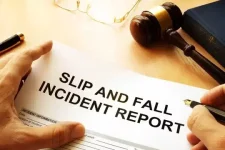
Where Do Most Slip And Fall Accidents Happen, And Why?
Slip and fall accidents can happen anywhere, anytime, to anyone. Accidents can result in serious injuries and may have long-term consequences. Such incidents are very common and can happen almost anywhere, including homes, workplaces, and even public areas. Poor lighting, wet or slippery floors, cluttered walkways, or uneven surfaces are common causes of such accidents. To prevent accidents, businesses and individuals should take proactive measures such as conducting regular maintenance checks, training employees, and installing safety equipment. By prioritizing a culture of awareness and accountability, communities can work together to create safer environments for everyone. This can be achieved by fostering a sense of responsibility and ensuring everyone knows the potential risks. Ellis Personal Injury Law Firm has provided some of the more common locations that slip and fall accidents take place and what legal recourse you may have.
- Retail Stores and Supermarkets: Supermarkets and retail stores are bustling environments filled with shoppers, employees, and various obstacles. Spills from products, leaks from refrigeration units, or even uneven flooring can create hazardous conditions. In busy areas with constant foot traffic, the risk of slip-and-fall accidents increases significantly.
- Restaurants and Bars: In dining establishments, the combination of food and beverages, along with hard surfaces, presents a considerable risk of slip and fall accidents. Spills from drinks, greasy kitchen floors, and poorly maintained restrooms can contribute to these accidents. Dimly lit areas or crowded spaces further exacerbate the risk.
- Workplaces: Offices, factories, and other workplaces are not exempt from slip and fall hazards. Loose cables, wet floors, uneven surfaces, and poor lighting are some common causes. Employers are responsible for ensuring a safe working environment, but negligence or oversight can lead to accidents and potential legal liabilities.
- Outdoor Areas: Slip and fall accidents can occur in outdoor and indoor spaces. Outdoor areas such as parking lots, sidewalks, and public parks also pose risks. Weather conditions like rain, snow, or ice can make surfaces slippery. Poorly maintained pathways or inadequate lighting can further increase the likelihood of accidents, especially during nighttime.
- Residential Properties: Homes and apartment buildings are not immune to slip and fall accidents. Wet bathroom floors, poorly maintained stairs, and cluttered walkways can all contribute to falls within residential settings. Elderly individuals and young children are particularly vulnerable to these hazards.
- Construction Sites: Construction sites are inherently dangerous environments, with various hazards at every turn. Uneven terrain, debris, exposed wires, and incomplete structures pose severe risks for slip and fall accidents. Workers should follow proper safety protocols, but accidents can still occur due to negligence or unforeseen circumstances.
- Hospitals and Healthcare Facilities: While hospitals are places of healing, they also harbor potential dangers for slip and fall accidents. Spills from medications or fluids, slippery floors in patient rooms or corridors, and cluttered hallways can all contribute to accidents. Patients with mobility issues or weakened conditions are especially susceptible.
Now that we’ve explored where these types of accidents commonly occur let’s examine why these incidents happen:
Ignoring risks like spills or uneven surfaces can cause slip-and-fall accidents. These hazards can be made worse by inadequate lighting, which makes it hard to see potential dangers. Rushed or distracted behavior can increase the likelihood of slip and fall accidents. In today’s fast-paced world, people may overlook hazards or fail to take necessary precautions. Whether it’s texting while walking or disregarding warning signs, distractions can have serious consequences.
Furthermore, certain demographic factors can contribute to slip and fall accidents. Elderly individuals, for example, are more prone to falls due to age-related decline in balance and mobility. Similarly, children may be at risk due to their propensity for exploring and lack of awareness of potential dangers.
Sometimes, these accidents are entirely preventable with proper maintenance, signage, and awareness. To make workplaces and properties safer, owners and managers must take action to prevent accidents. This includes fixing hazards quickly, educating employees and visitors about potential risks, and regularly checking the premises for any issues. Repairing damaged infrastructure and using non-slip flooring can also reduce the likelihood of accidents. Encouraging open communication channels for reporting hazards empowers individuals to contribute to a safer environment. By investing in safety, businesses and property owners can protect themselves from legal liabilities, build a positive reputation, and improve community well-being.
Slip and fall accidents can happen almost anywhere you go, such as shops, workplaces, outdoors, homes, etc. These accidents often occur due to negligence, environmental hazards, or human error. Individuals and businesses need to identify common locations and root causes to prevent them from happening. Safety measures like public awareness campaigns, collaboration with safety organizations, and regular safety training sessions can help create a safety culture. By working together to address potential risks, we can make slip-and-fall accidents a rare occurrence.






